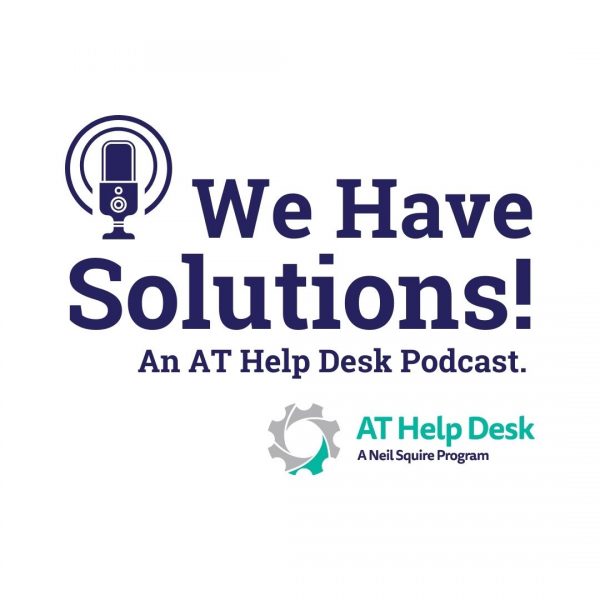We Have Solutions! – Episode 24: NFC-Based Automation, Reading Tools for Teams, and Our New Favourite AI

On this episode, our AT Help Desk team talks about NFC-based automation for persons with disabilities, the Reading Progress and Reaching Coach tools that are now available for Teams, and finally we look at another AI chatbot that just might be our new favorite.
Reading Coach: A Teams-Based Learning Tool

By now most of us are aware of and have likely used Microsoft Teams. For those who aren’t familiar, Teams is a widely used communication platform that integrates all things Microsoft into a centralized space. Teams is also an incredible tool for teachers with a wide range of educational tools. But with the plethora of supporting apps that integrate into Teams, there’s going to be apps and add-ons that fly under the radar. Today we are going to talk about one of Teams’ supporting apps that you should definitely be aware of!
Top Three AI Chatbots and How to Use Them

In a previous e-bulletin we started to explore the concept of using AI as AT. We learned that there are many ways in which this new technology can be helpful to students, professionals, persons with disabilities, and beyond. We discovered that AI chatbots were even better at finding and synthesizing information than a traditional browser, and that the flexible, conversational nature of this technology is ideal for diving into a variety of complicated subjects. With that in mind, we are going to dive even deeper into what these chatbots are capable of as well as identifying and comparing the top three chatbots on the market right now.
Resource Spotlight: PRC-Saltillo

Today we are going to do a quick spotlight on a great assistive technology resource that we have recently discovered. This resource deals with Augmentative and Alternative Communication (AAC) technology, so before we go any further, we want to mention that the New Brunswick Association of Speech-Language Pathologists and Audiologists is the province’s main resource for everything related to speech and audio challenges. Click here to check out their website.
There’s not always a ton of resources and knowledge available when it comes to AAC. This probably has a lot to do with the specialized nature of AAC technology. This tech is often expensive, and it usually requires a bit of training to use properly.
Udemy

Adult learning can be an incredibly expensive and time-consuming process, but it doesn’t have to be! With the advent of online learning there are more choices than ever in how we can approach post-secondary education. There’s a lot of options out there, and we have covered some of them in past e-bulletins, so if you’re interested in even more online learning options, please click here. However, the app that we are looking at today certainly deserves its time in the spotlight, especially because of the strides they’ve recently been making to deliver an accessible and universally designed product.
Udemy is an online learning system that is available on iOS, Android, PC, and Mac. The courses are adult-centered and deal with a wide variety of practical skills. There are courses on software development, business, photography, editing, teaching and academics, IT, music, and much more.
PrintFriendly PDF Maker

If you’ve ever worked with PDFs, you’ve probably heard of Adobe Acrobat and Reader. And if you’ve heard of those products, you probably also know two other things. One, that Adobe products are the best for working with PDFs, and two, that Adobe software is very expensive. Both of these things are very true. However, if you are a working professional who generates a lot of digital paperwork, it’s going to be hard to recommend anything else but Adobe Acrobat.
But what if you’re a student who maybe generates a PDF here and there, but you don’t need anything too fancy, and you don’t want a product that’s going to break the bank?
We Have Solutions! – Episode 23: ATIA 2024

Today the AT Help Desk team are joined by Neil Squire colleagues Erin and Todd after their return from the ATIA 2024 conference.
In case you’re not aware, ATIA is the leading community-building and learning event for all things Assistive Technology.
Lookout Vision App

We’ve talked a bit in the past about apps and services designed for individuals with low or no vision, but it’s been a few years since we’ve featured something new. In fact, we highly recommend you look at our previous e-bulletins for even more recommendations for vision-related apps and services, especially since the app that we are looking at today is for Android only.
Lookout is an assisted vision app created by Google. It uses your smartphone’s camera in conjunction with powerful AI to capture and describe the world around you. The app also has some universal design potential in that it could also be helpful for those with print-based disabilities.
Action Blocks

One of the greatest things about modern smartphones is the level of customization that is available to its users. Developers today are so much more conscious about how their technology might be used, especially when it comes to offering Accessible apps and services. In fact, besting the other brands accessibility is a major driving factor for both Google and Apple. And as we’ve mentioned before, at the time of me writing this article, both companies are doing an amazing job with their current built-in accessibility tools.
KiwiWrite Math

Alternative math apps are always so interesting to me. Growing up in the 90’s, we only had access to pens and calculators, but with today’s technology we have so many choices in how we want to approach math. This is especially important for persons with disabilities who might otherwise struggle with math for a variety of reasons. In fact, if you look back at our previous e-bulletins, we have over 40 articles solely devoted to math apps, so if you haven’t already, take a look at what we’ve already covered.
The app that we are looking at today is based around the concept of math without the need for handwriting. For students with dysgraphia, dyscalculia, or fine motor control challenges, this approach to learning and solving math could be a complete game changer.



